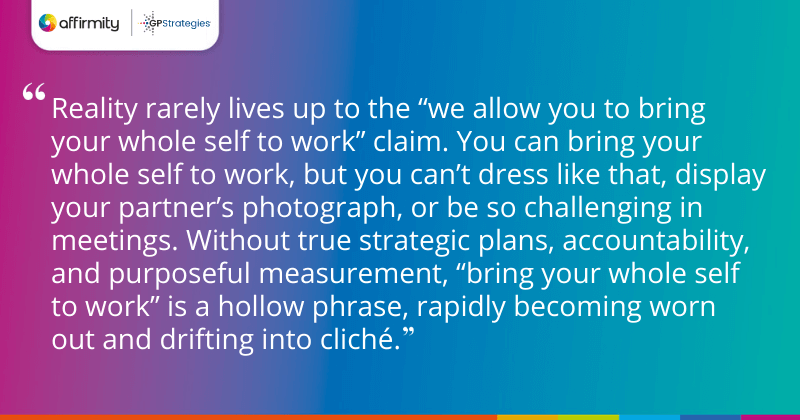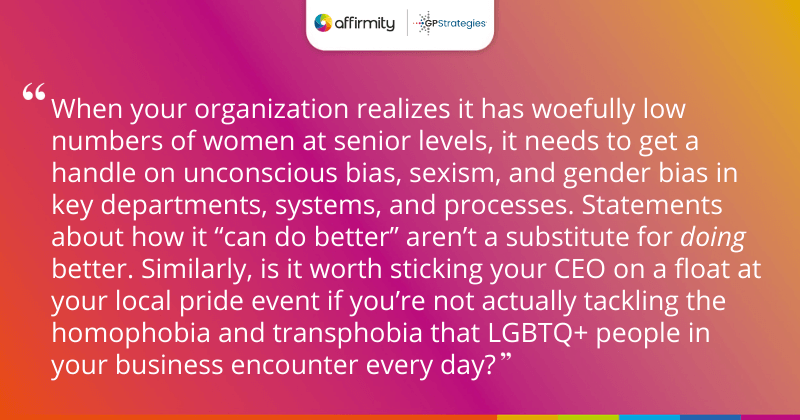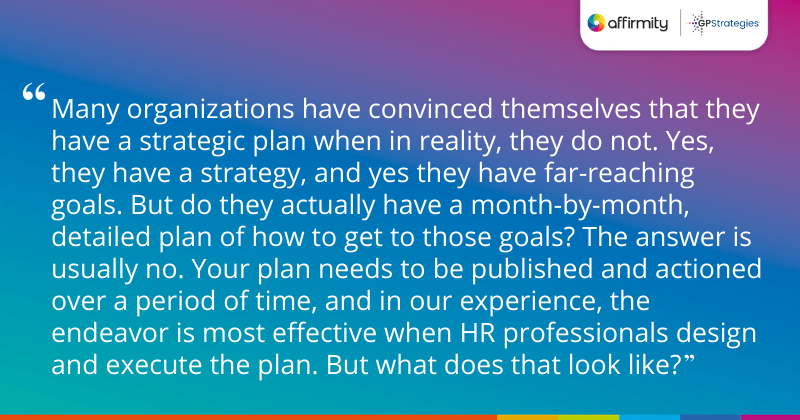Organizations of every shape and size use the phrase “bring your whole self to work.” However, failing to stand by this statement may be causing untold damage to your diversity and inclusion programs and the reputation of your organization. In this article, Angie Peacock, Director of Global Diversity and Inclusion at GP Strategies (an Affirmity inclusion training partner), takes an honest look at this all-too-ambitious goal.
Picture this: you’ve been in a new role for a couple of months. As you’re always on the lookout for the next chance to move beyond being the new face in the business, you spy an invite to an annual social event in the company newsletter. They’re holding a family fun day, with a cartoon character fancy dress theme, and actually, it sounds like the perfect event. From the kids’ bedrooms to the home office, your house is practically a shrine to all things Disney, Marvel, DreamWorks, and beyond. You just know everyone will get into the spirit of things.
Sure enough, on the day of the event, you and your family can be seen emerging from your station wagon as a menagerie of cartoon supervillains, Disney princesses, and other faces from well-loved comics and films. But what you see is the entire organization, from the CEO down through the C-Suite to your peers, dressed in shorts and sneakers. Suddenly, you’re very conscious that everyone is staring at both you and your family. Nobody is saying it, but you know they’re all thinking it: “What on earth could have possessed you?”
It’s an embarrassing moment, to be sure. But it feels worse for the false sense of security you were lured into. Later, you look over the original newsletter and realize that tucked away in the corner in a small font, there’s the word “optional”. You realize all at once that the unwritten rules of the organization are “we all stay the same, we keep it quiet, we don’t rock the boat”. Other employees—even their families—know how to play the game.
MORE FROM THE BLOG | ‘5 Things Your Resource Groups Need In Order to Truly Drive Inclusion’

Stop Promising What Can’t Be Delivered
Something similar to this little scenario plays out every time a person from a historically marginalized group takes a role at an organization that boldly claims “we allow you to bring your whole self to work”. Reality rarely lives up to this claim. You can bring your whole self to work, but you can’t dress like that, display your partner’s photograph, or be so challenging in meetings.
Without true strategic plans, accountability, and purposeful measurement, “bring your whole self to work” is a hollow phrase, rapidly becoming worn out and drifting into meaningless cliché. So, let’s take a closer look at how to start backing the statement with real cultural change.
The popularity of “Bring your whole self to work” reflects the tendency for organizations, and people in general, to fall back on superficially admirable, emotionally easy actions that sidestep the difficult work we all need to be doing to create real change. It’s the same reflex that caused organizations to post a black square on social media and at most maybe reach out to their ERGs for guidance back in summer 2020. These are gestures that don’t actually address the underlying problem.
FURTHER USEFUL READING | ‘3 Ways to Have Intersectionality Signpost the Road to Equity’

Are You Really Rooting Out Moments of Exclusion?
When your organization runs the numbers and realizes it has woefully low numbers of women at senior levels, it needs to get a handle on unconscious bias, sexism, and gender bias in key departments, systems, and processes. Statements about how it “can do better” aren’t a substitute for doing better. Similarly, is it worth sticking your CEO on a float at your local pride event if you’re not actually tackling the homophobia and transphobia that LGBTQ+ people in your business encounter every day?
We’ve previously run a rather illuminating exercise with our clients: we collate all their statements on diversity topics from internal and external sources and ask employees to identify those that they believe are actually representative of their experience of working there. The success rate is almost always very low.
Whether or not you were to run such an exercise in your organization, it’s important to identify and root out these kinds of performative behaviors in communications and DE&I strategy.
THOUGHTS ON UNCONSCIOUS BIAS | ‘5 Unconscious Bias Myths and 5 Great Ways to Challenge Them’

Conclusion: Why HR Is In the Driving Seat
Three things are needed if an organization is truly committed to the “bring your whole self to work” promise:
- Measurement with a purpose
- Accountability through performance
- A strategic plan
The third element is particularly important, because many organizations have convinced themselves that they have a strategic plan when in reality, they do not. Yes, they have a strategy, and yes they have far-reaching goals. But do they actually have a month-by-month, detailed plan of how to get to those goals? The answer is usually no.
For example, if you are planning to tackle the systemic bias in your recruitment process, you should know:
- When you’re going to start to examine the process
- How you’re going to design or redesign the process
- How you will relaunch the process
- How you will measure its effectiveness
- How you will hold people accountable to it
Your plan needs to be published and actioned over a period of time, and in our experience, the endeavor is most effective when HR professionals design and execute the plan. But what does that look like?
HR should publish an 18-month to two-year plan showing in detail when they’re going to improve processes, pilot, and measure the results. Then, every single executive leader (whether regional, business unit, or some dividing line in your business) should develop their own month-by-month plan reflecting on how their part of the business will support these changes, and how they will in turn be held accountable for embedding them. And of course, leadership accountability is usually best achieved by making it a part of the performance management process.
If you would like to discuss how to become a more diverse, inclusive, and equitable organization, please contact us today.
A version of this article originally appeared in HR.com’s Talent Management Excellence epublication.
 About the Author
About the Author
Angela Peacock is the Global Director of Diversity and Inclusion at GP Strategies. Through the work of hundreds of clients across 20 years of global DE&I experience, Angela has seen the good, the bad, and the downright idiotic: she pulls no punches and has learned that by having frank, strategic, and not just well-meaning conversations, organizations can drive better results and excel in terms of diversity, inclusion, and business performance.
